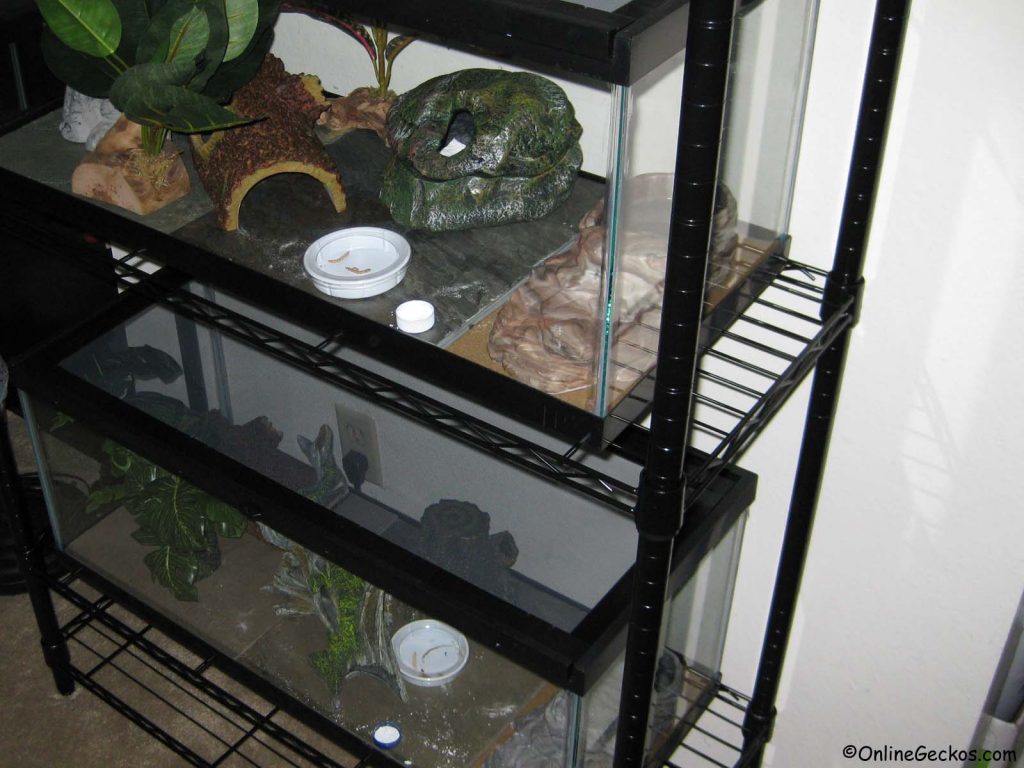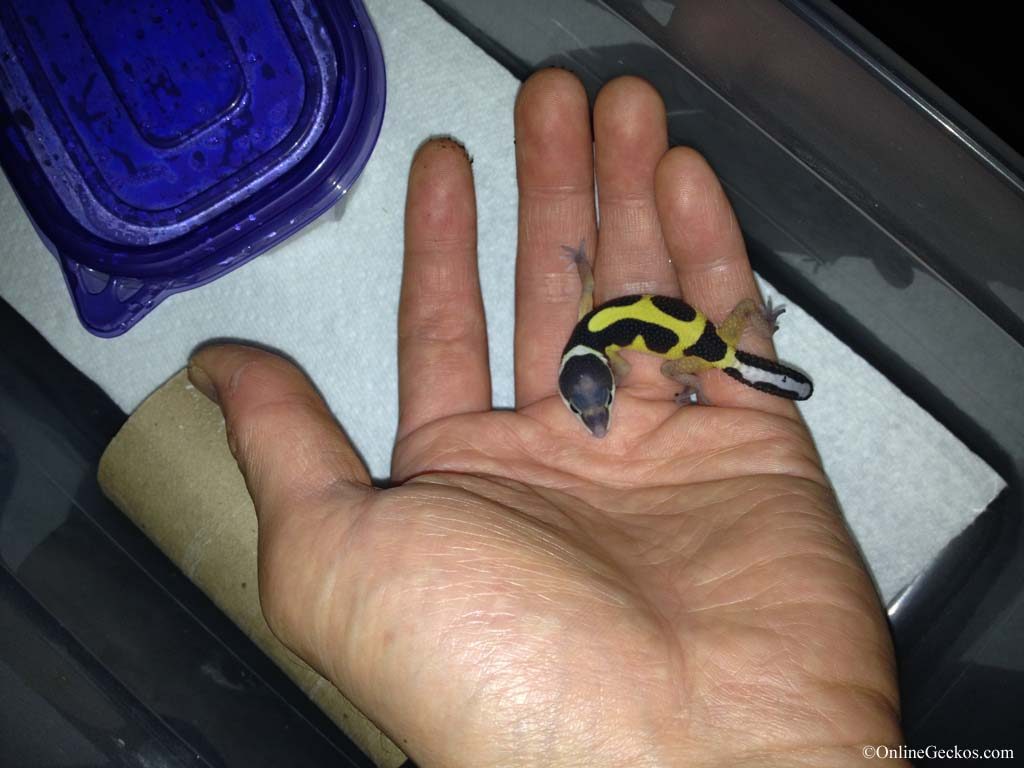Leopard gecko (Eublepharis macularius) make for great beginner pet lizards for hobbyists of all ages. Crepuscular in nature, they are the most active during twilight around dusk and dawn. Due to their gentle and docile temperament, leopard geckos are one of the best reptile pets for handling. They are usually skittish when they are young, but they become much more docile and calm as they get older.
Best Reptile Pets For Handling
Leopard geckos tolerate handling very well. They are coldblooded animals, so they will often lay on the palm of your hand to enjoy the warmth of your hand. Unlike other gecko species, leopard geckos are ground-dwelling lizards with claws instead of sticky pads on their feet. You can feel their claws when they hold on to you, but it won’t hurt as their claws are very small.
Leopard geckos rarely bite unless threatened. Key to not spook a leopard gecko is by slow movements. When approaching them with your hands, try to approach from the side of them and scoop them up. If you approach from the backside and touch their tail first, they may get spooked. When you see a leopard gecko wave their tail slowly back and forth, that’s their defensive posture. This tail waving behavior means they are spooked and you should wait until they calm down before attempting to pick them up.
If you have experience with pet iguanas before, you know iguanas get very aggressive once they reach sexual maturity. In fact most of the iguana owners end up giving their iguanas away once they become unmanageable. Their tail whips hurt, they become really difficult to hold as they age. Leopard geckos do not have this issue. Leopard geckos actually get more docile as they get older, and this is why leopard geckos are one of the best reptile pets for handling.
Best Beginner Pet Lizards – Leopard Gecko As Pets
Leopard geckos make ideal beginner pet lizards. They do not smell and do not make noise. When leopard geckos defecate, they will pick one spot and always defecate in the same spot. This makes for easy cleaning as you can place a piece of paper towel there, and just change out the paper towels as needed.
Leopard geckos also stay at a manageable size. Unlike iguanas and bearded dragons, leopard geckos do not keep growing, forcing you to upgrade your tanks frequently. You can have a nice 20-gallon long tank, or one of those beautiful Exo Terra All Glass terrariums, tucked neatly on a shelf in the corner of your room. No upgrades will ever be needed because a 20-gallon is perfect for a single leopard gecko.
You can even setup a nice shelving system using Whitmor Supreme 4-tier shelving unit. With this shelving system, you can stack multiple tanks vertically. This saves you space, and they will look great in any room. Because let’s face it, once you experience having leopard gecko as pets, you will want to have more than one. You can effectively own multiple leopard geckos without turning your living space into a jungle. This makes leopard geckos very ambiance and guest-friendly. Those with limited space to work with will find leopard geckos to be the perfect beginner reptiles to own.
Leopard geckos being docile in nature, easy to care for, easy to keep clean, and easy to handle are all reasons why leopard geckos are the best beginner pet lizards.
Best Reptile Pets For Handling – Caring For Leopard Geckos
Leopard geckos are extremely easy to care for. We have a complete leopard gecko care sheet for you to learn everything there is to caring for leopard geckos. You can also read our leopard gecko tank setup guide to learn how to properly setup a basic leopard gecko habitat. See below for a quick checklist.
Leopard Gecko Tank & Housing Setup
1. You will need a tank with mesh top. The tank needs to be at the minimum 10 gallon size (ideal for a juvenile leopard gecko), but the most common size for a leopard gecko adult is a 20 gallon long (30x12x12). You can have a larger tank, but shoot for at least 10-20 gallon for a single gecko.
There are some really nice front opening Exo Terra tanks that we really like. If budget suits you, consider them as they’ll make cleaning and handling the geckos so much easier. Not to mention they are beautiful to look at.
2. You will need an under-tank heating pad. Leopard geckos digest food through belly heat, this is why under tank heating pads are preferred over basking light. You want to cover 1/3 of your tank with the pad, so get the measurement before purchasing them. Zoo Med ReptiTherm is a popular under tank heating pad brand, Amazon’s #1 Best Seller. We recommend them.
We also recommend you purchase a digital thermostat to use with your under tank heating pad. A thermostat will regulate your pad’s temperature so it won’t get too hot for your gecko. Your ideal floor temperature should be between 88-93 degrees. Hydrofarm MTPRTC Digital Thermostat is what we recommend. It has thousands of positive reviews to back up its reliability and reputation.
While this leopard gecko care sheet can give you the quick overview of what you need, we have a complete guide that will show you how to install the under tank heating pad and setup the digital thermostat. Click here for full detailed comprehensive guide to leopard gecko’s temperature and heating needs.
3. For tank’s substrate, we recommend slate/ceramic tiles or paper towels. You can get the tiles from your local hardware stores. If you have a standard 30x12x12 long tank, you can easily fit 12×12 ceramic tiles in them. They are the best and safest substrate for your leopard geckos.
For moist-hide we recommend Eco Earth coco fiber. Coco fiber is great to use as moist hide substrate, and it doubles well for female’s laybox substrate if your female needs to lay eggs.
4. You will need 3 hides, a warm hide, a moist hide, and a cool hide. These 3 hides will allow your leopard gecko to feel safe in their living environment. The moist hide should be placed between your warm & cool side, somewhere in the middle, so it stays warm and humid for your gecko. Moist-hide is needed so your leopard gecko can shed properly. Hides should be tight fitting hides so your gecko will feel safe and secure.
If you take a look a the picture of the tank above, you’ll see that there are the warm hides on the left, the moist hide in the middle, and the cool hide to the right. With ceramic tiles as substrate, and paper towels laying over the left-over spot. Inside the moist hide is eco earth coco fiber for the female. This is pretty much all you need to have a proper tank setup for your leopard gecko.
Feeding and Vitamin Dusting
Leopard geckos are insectivores. You will want to feed your gecko a variety of insects such as crickets, dubia roaches, superworms, mealworms, waxworms, hornworms, etc.. We purchase our feeders from Rainbowmealworms, they have good variety and great prices.
For multivitamin supplement you will want to purchase Repashy Calcium Plus or Zoo Med Reptivite with D3. They are all-in-one multivitamin supplement, either one will do just fine for you. No additional supplement is needed if you use one of these vitamin powders.
What you wan to do is to dust your insects at every feeding. For juvenile geckos, you want to feed them every day. So you would dust every day. Once your gecko matures, such as adults over 1 year old, they will eat less. You will still want to dust at every feeding, usually every 3-4 days.
You should always have fresh water in the tank, so make sure you get a nice water dish. Exo Terra water dish is nice as its nonporous surface prevents bacteria buildup and absorption. Also it helps to have a nice escape-proof mealworm dish, such as OMEM mealworm dish, ceramics made.
To read more about how to supplement, dust, and gut-load your feeders, please visit our comprehensive leopard gecko multivitamin supplement guide. The guide will explain to you leopard gecko’s vitamin needs, including the popular questions about calcium and D3.
We’ve also added a new leopard gecko feeder insects nutritional values guide. Please have a look if you would like to learn more about popular feeder insects used for leopard gecko feeding.
Thermometer, Humidity, and More
The stick on thermometer you get from retail kits are useless. Leopard gecko require belly heat, while the stick on thermometer only tell you the air temperature. To monitor the floor temperature you need either a thermometer with a probe, or a temperature gun.
Leopard geckos have no special humidity requirement. However persistent high humidity can cause upper respiratory infection. By using a moist-hide/laybox, you isolate the high humidity spot so it won’t be humid all throughout the tank. Your leopard gecko will go inside the moist-hide to shed and rest.
What if my leopard gecko stops eating?
Please read our detailed guide on what to look for when your gecko stops eating or behaviors change.





